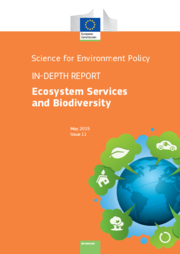Business and Biodiversity: Intro: Biodiversity and Ecosystem Services

Intro: Biodiversity and Ecosystem Services
Nature’s Diversity – Endangered Foundation of Life and Economy
Biological diversity or biodiversity means the variability among living organisms from all sources including, inter alia, terrestrial, marine and other aquatic ecosystems and the ecological complexes of which they are part; this includes diversity within species, between species and of ecosystems. As such, biodiversity is the fundament for "life on earth", the basis for a nature human beings can live in. It is key to ecosystem functioning. Overall, a high biodiversity is a good guarantee for the adaptability of nature and its ecosystems.
The anthropegenic impact on biodiversity is significant, the ecological footprint of human civilization leads to a dramatic loss of species and biological diversity. Biodiversity is declining rapidly due to these main threats:
- Environmental Pollution (Emissions/Pollution)
- Climate Change
- Overexploitation of natural resources
- Habitat Destruction/Change
- Invasive alien species.
Despite all uncertainties, there is a consensus that the current extinction rate is 100 to 1,000 times higher than the normal background extinction rate, and that this causes severe threats for the well-being of nature and mankind. We benefit and depend on several ecosystem services that only a robust nature can provide:
Provisioning services: Material or energy outputs from ecosystems. They include food, water and other resources.
Regulating services: Ecosystems provide them by serving as regulators, for instance regulating the quality of air, climate and soil or providing flood and disease control.
Cultural services: non-material benefits with nonetheless material significance (e. g. tourism!), comprising for instance spiritual enrichment, cognitive development, reflection, recreation and aesthetic experiences
Supporting services: underpinning the production of all other ecosystem services including soil formation, photosynthesis, primary production, nutrient cycling and water cycling.
Ecosystems have a natural resilience and ability to regenerate, for nature is resourceful and creative. But they too have their limitations. It is one of the key challenges of our time to protect our natural basis of life.
The International Community’s Engagement
The international community has taken up this challenge and adopted the ‘Convention on Biological Diversity’ (CBD) at the United Nations Conference on Environment and Development, which took place in Rio de Janeiro in 1992. Today, more than 190 nations are party to the Convention. The CBD puts forward three concrete goals:
- the conservation of biological diversity,
- the sustainable use of its components and
- the fair and equitable sharing of the benefits arising out of the utilization of genetic resources.
Since then, regular Conferences of the Parties to the Convention (COP) have been striving to make advances towards this end, as was symbolically represented in 2010 – the Year of Biodiversity. Eight years prior to this, the United Nations had agreed upon completely stopping biodiversity loss, or at least significantly slowing its degradation. Preliminary results were dismal and the goal was not achieved. At the 2010 COP 10 in Nagoya, Japan, the Aichi Biodiversity Targets were formulated with 20 specific goals to be achieved by 2020. In an effort to create more awareness to further support reaching these goals, the United Nations declared the 2011-2020 period to be the United Nation’s Decade on Biodiversity.
Germany is working towards this goal with its 2007 National Strategy on Biological Diversity.
Access to Genetic Resources and the Fair and Equitable Sharing of Benefits: ABS
In Nagoya, international biodiversity protection achieved a break through as the CBD-CoP states approved the Nagoya Protocol on Access to Genetic Resources and the Fair and Equitable Sharing of Benefits Arising from their Utilization to the Convention on Biological Diversity. Access and benefit- sharing (ABS) is an important step towards increased ecological and social sustainability. However there is still much to do before the protocol's goals have been implemented and translated into action.
Naturally, states will maintain sovereignty over their genetic resources, but should also guarantee access to these resources according to mutually agreed and transparent conditions. Users, for example from the pharmaceutical industry, who use plant-based raw materials, are obliged to equitably share the benefits arising from the utilization of knowledge, innovations and practices of indigenous and local communities who were instrumental in developing the plant-based raw materials.
The new protocol intends to set the basis for increased legal security and stable processes in using nature’s resources. Additionally, it guarantees that those who help in supplying methods, information, and access to these resources will benefit from the profits. Enterprises should be prepared to adapt to new legal requirements in the near future that may necessitate a restructuring of resource management departments. In the long run, this will secure resources and strengthen social balance.
Placing a Value on the Invaluable: The TEEB Report
Things that cannot be represented by “hard cash” or where the value cannot be literally defined very often find no place political and economic activity. We have a difficult time integrating such thinking into our economically-programmed logic. For this reason there have been great measures taken to understand and pace a cost on realities such as climate change and biodiversity. Because of increasing populations striving for increasing wealth creation, nature and its resources can also be viewed from the perspective of precious and scarce commodities. For this reason, it is high time to place an economic value on the free gift nature provides us with and to develop mechanisms that fairly and sustainably utilize the profits we gain. It is only after we understand the economic consequences of damaging our ecosystems that we can understand what it costs to preserve biodiversity and what it costs to do nothing. However, it is noteworthy to add that this must not mean "commodifying" nature!
Under the auspices of the G8 presidency in 2007, Germany together with the European Commission initiated the study “The Economics of Ecosystems and Biodiversity” (TEEB) that was implemented through the United Nations Environment Programme (UNEP). For more information on the study results visit: www.teebweb.org
The TEEB study shows that the economic value of the ecosystem services is much higher than previously thought. Effective protection of biodiversity is certainly not cheap. Nevertheless, the costs for this are significantly less than the price we will have to pay if we allow the current rate of biodiversity loss to continue unchecked. For this reason, it makes sense to invest in protection now, to avoid being saddled with an unaffordable bill in the future.
TEEB for Business is a report meant to sensitise enterprises about the high risks represented by biodiversity loss and what their options for action are. It is an appeal to businesses to build up a sustainable biodiversity management system as well as analyse and balance out the positive and negative affects this has on their value-added processes. Additionally, businesses should develop management standards and indicators. The ‘Biodiversity in Good Company’ Initiative’s Leadership Declaration takes account of these findings.
How ecosystem services and biodiversity interact - worth reading:

Science for Environment Policy (2015): Ecosystem Services and Biodiversity. In-depth Report 11 produced for the European Commission, DG Environment by the Science Communication Unit, UWE, Bristol. PDF Download